Introduction to Finance: Analysis and Capital Budgeting
VerifiedAdded on 2023/01/16
|11
|1257
|100
Homework Assignment
AI Summary
This finance assignment analyzes the financial performance of two companies, Dimetime and Primetime, using various financial ratios such as gross profit margin, net profit margin, current ratio, and debt-equity ratio. The analysis reveals that Dimetime exhibits better liquidity and profitability. The assignment also delves into capital budgeting techniques, including calculating the Average Rate of Return (ARR), payback period, discounted payback period, and Net Present Value (NPV) for two hypothetical projects, Project A and Project B. Based on the analysis, Project B is deemed more viable due to its higher NPV and shorter payback period. The solution also explains the differences between discounted and non-discounted investment appraisal techniques, discussing why the discounted payback technique is rarely used. The assignment concludes with a list of references.

Introduction to finance
Paraphrase This Document
Need a fresh take? Get an instant paraphrase of this document with our AI Paraphraser

Table of Contents
Question 2........................................................................................................................................3
Question 4........................................................................................................................................4
a. calculation of capital budgeting technique...............................................................................4
b. Difference between discounted and the non-discounted techniques of an investment
appraisal and the reasons behind rare use of the discounted payback technique ........................8
REFERENCES................................................................................................................................1
Question 2........................................................................................................................................3
Question 4........................................................................................................................................4
a. calculation of capital budgeting technique...............................................................................4
b. Difference between discounted and the non-discounted techniques of an investment
appraisal and the reasons behind rare use of the discounted payback technique ........................8
REFERENCES................................................................................................................................1
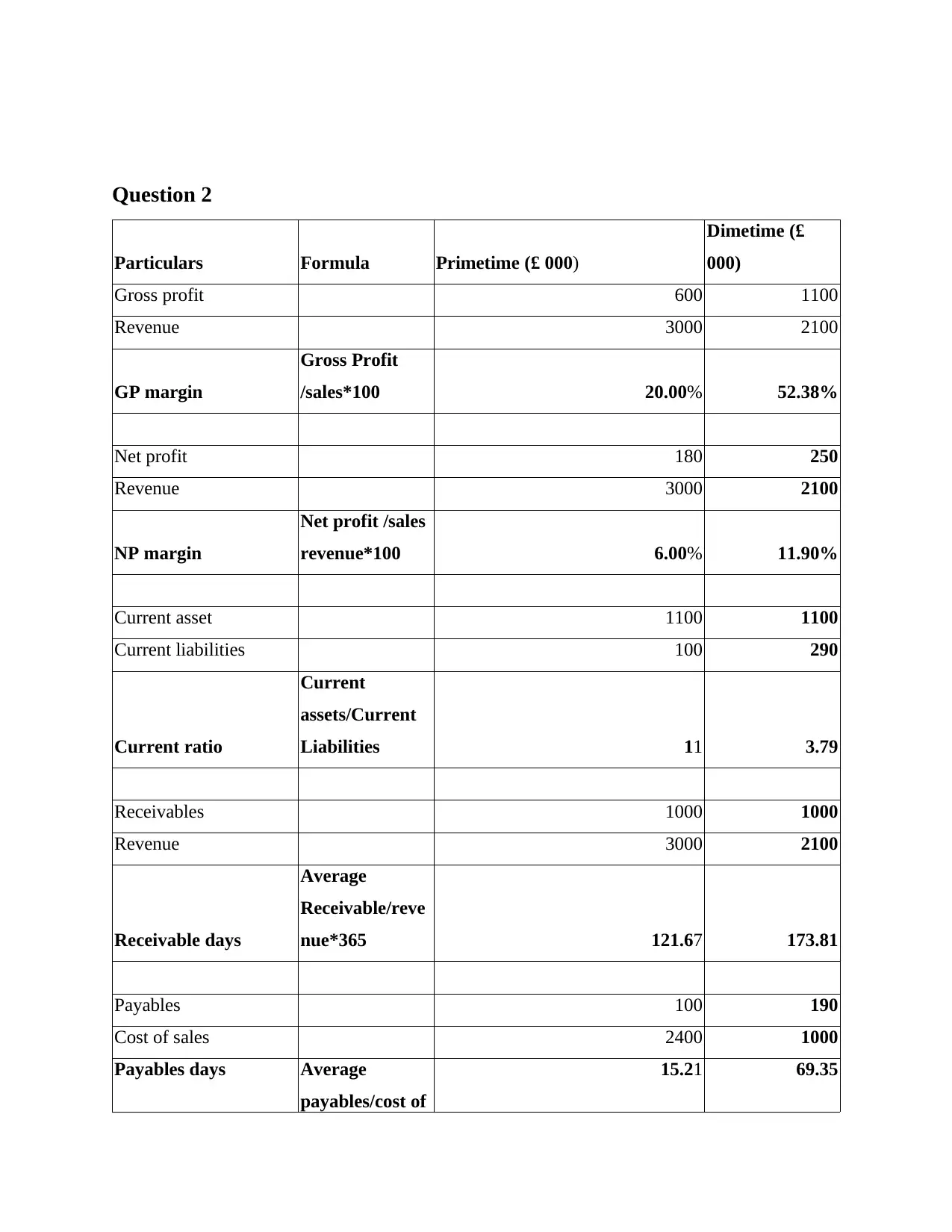
Question 2
Particulars Formula Primetime (£ 000)
Dimetime (£
000)
Gross profit 600 1100
Revenue 3000 2100
GP margin
Gross Profit
/sales*100 20.00% 52.38%
Net profit 180 250
Revenue 3000 2100
NP margin
Net profit /sales
revenue*100 6.00% 11.90%
Current asset 1100 1100
Current liabilities 100 290
Current ratio
Current
assets/Current
Liabilities 11 3.79
Receivables 1000 1000
Revenue 3000 2100
Receivable days
Average
Receivable/reve
nue*365 121.67 173.81
Payables 100 190
Cost of sales 2400 1000
Payables days Average
payables/cost of
15.21 69.35
Particulars Formula Primetime (£ 000)
Dimetime (£
000)
Gross profit 600 1100
Revenue 3000 2100
GP margin
Gross Profit
/sales*100 20.00% 52.38%
Net profit 180 250
Revenue 3000 2100
NP margin
Net profit /sales
revenue*100 6.00% 11.90%
Current asset 1100 1100
Current liabilities 100 290
Current ratio
Current
assets/Current
Liabilities 11 3.79
Receivables 1000 1000
Revenue 3000 2100
Receivable days
Average
Receivable/reve
nue*365 121.67 173.81
Payables 100 190
Cost of sales 2400 1000
Payables days Average
payables/cost of
15.21 69.35
⊘ This is a preview!⊘
Do you want full access?
Subscribe today to unlock all pages.

Trusted by 1+ million students worldwide
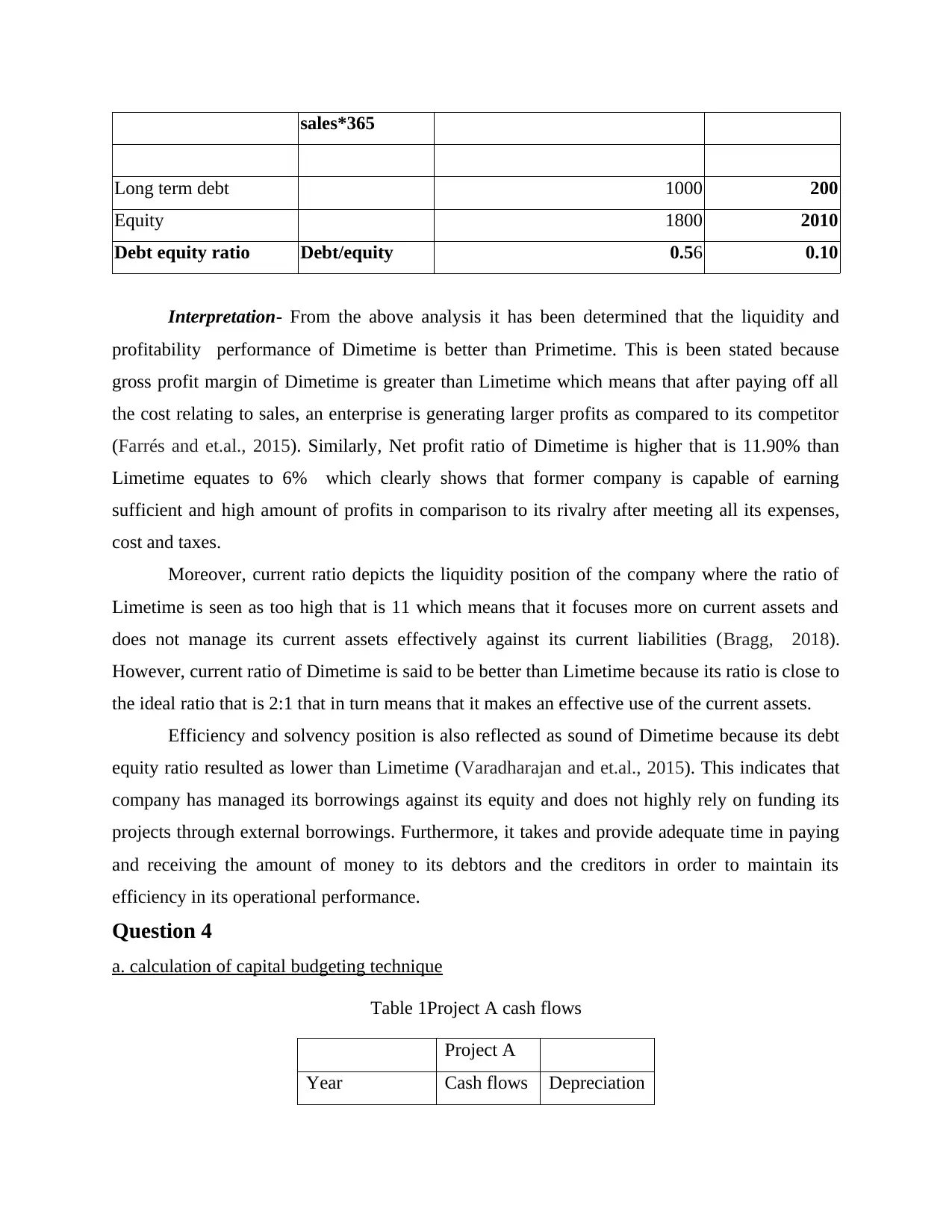
sales*365
Long term debt 1000 200
Equity 1800 2010
Debt equity ratio Debt/equity 0.56 0.10
Interpretation- From the above analysis it has been determined that the liquidity and
profitability performance of Dimetime is better than Primetime. This is been stated because
gross profit margin of Dimetime is greater than Limetime which means that after paying off all
the cost relating to sales, an enterprise is generating larger profits as compared to its competitor
(Farrés and et.al., 2015). Similarly, Net profit ratio of Dimetime is higher that is 11.90% than
Limetime equates to 6% which clearly shows that former company is capable of earning
sufficient and high amount of profits in comparison to its rivalry after meeting all its expenses,
cost and taxes.
Moreover, current ratio depicts the liquidity position of the company where the ratio of
Limetime is seen as too high that is 11 which means that it focuses more on current assets and
does not manage its current assets effectively against its current liabilities (Bragg, 2018).
However, current ratio of Dimetime is said to be better than Limetime because its ratio is close to
the ideal ratio that is 2:1 that in turn means that it makes an effective use of the current assets.
Efficiency and solvency position is also reflected as sound of Dimetime because its debt
equity ratio resulted as lower than Limetime (Varadharajan and et.al., 2015). This indicates that
company has managed its borrowings against its equity and does not highly rely on funding its
projects through external borrowings. Furthermore, it takes and provide adequate time in paying
and receiving the amount of money to its debtors and the creditors in order to maintain its
efficiency in its operational performance.
Question 4
a. calculation of capital budgeting technique
Table 1Project A cash flows
Project A
Year Cash flows Depreciation
Long term debt 1000 200
Equity 1800 2010
Debt equity ratio Debt/equity 0.56 0.10
Interpretation- From the above analysis it has been determined that the liquidity and
profitability performance of Dimetime is better than Primetime. This is been stated because
gross profit margin of Dimetime is greater than Limetime which means that after paying off all
the cost relating to sales, an enterprise is generating larger profits as compared to its competitor
(Farrés and et.al., 2015). Similarly, Net profit ratio of Dimetime is higher that is 11.90% than
Limetime equates to 6% which clearly shows that former company is capable of earning
sufficient and high amount of profits in comparison to its rivalry after meeting all its expenses,
cost and taxes.
Moreover, current ratio depicts the liquidity position of the company where the ratio of
Limetime is seen as too high that is 11 which means that it focuses more on current assets and
does not manage its current assets effectively against its current liabilities (Bragg, 2018).
However, current ratio of Dimetime is said to be better than Limetime because its ratio is close to
the ideal ratio that is 2:1 that in turn means that it makes an effective use of the current assets.
Efficiency and solvency position is also reflected as sound of Dimetime because its debt
equity ratio resulted as lower than Limetime (Varadharajan and et.al., 2015). This indicates that
company has managed its borrowings against its equity and does not highly rely on funding its
projects through external borrowings. Furthermore, it takes and provide adequate time in paying
and receiving the amount of money to its debtors and the creditors in order to maintain its
efficiency in its operational performance.
Question 4
a. calculation of capital budgeting technique
Table 1Project A cash flows
Project A
Year Cash flows Depreciation
Paraphrase This Document
Need a fresh take? Get an instant paraphrase of this document with our AI Paraphraser
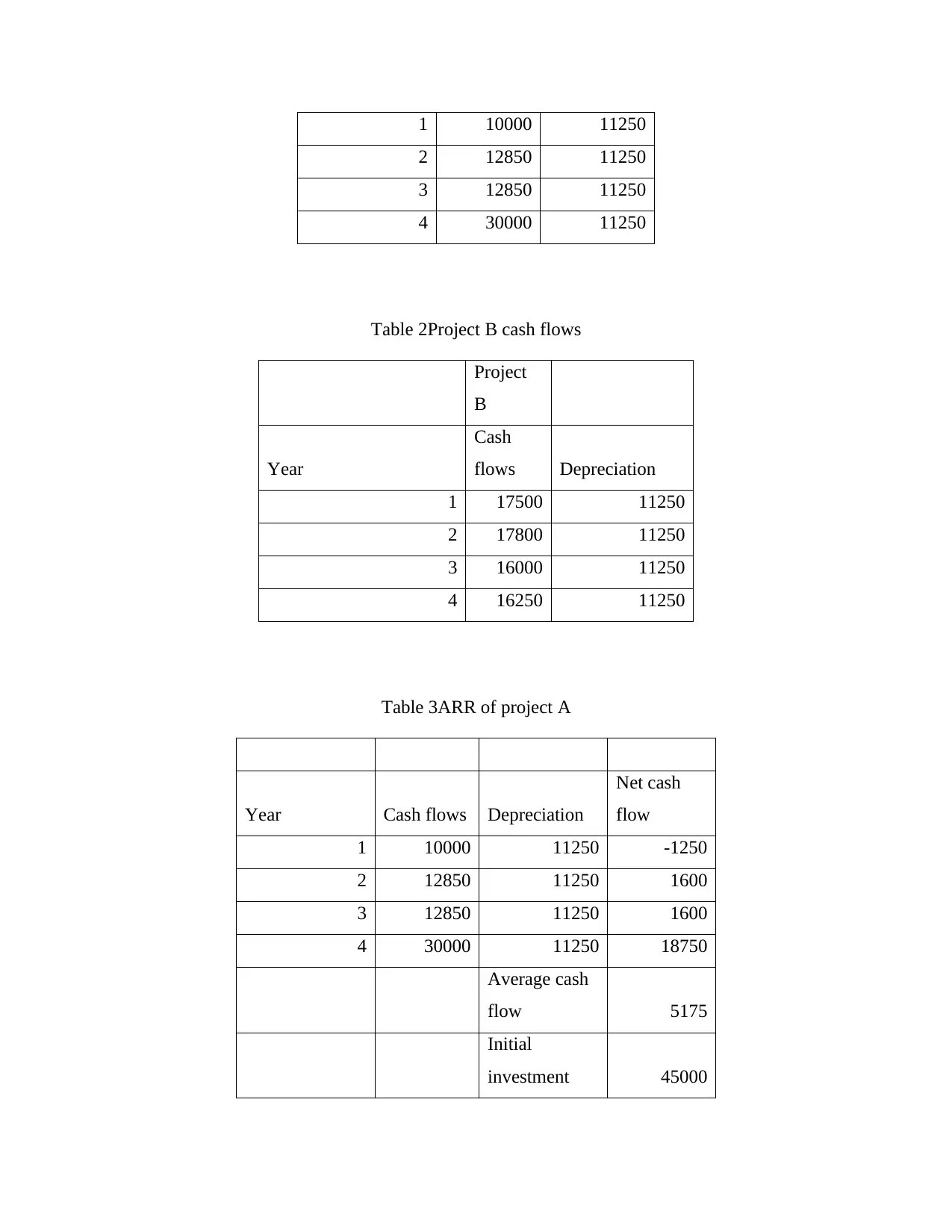
1 10000 11250
2 12850 11250
3 12850 11250
4 30000 11250
Table 2Project B cash flows
Project
B
Year
Cash
flows Depreciation
1 17500 11250
2 17800 11250
3 16000 11250
4 16250 11250
Table 3ARR of project A
Year Cash flows Depreciation
Net cash
flow
1 10000 11250 -1250
2 12850 11250 1600
3 12850 11250 1600
4 30000 11250 18750
Average cash
flow 5175
Initial
investment 45000
2 12850 11250
3 12850 11250
4 30000 11250
Table 2Project B cash flows
Project
B
Year
Cash
flows Depreciation
1 17500 11250
2 17800 11250
3 16000 11250
4 16250 11250
Table 3ARR of project A
Year Cash flows Depreciation
Net cash
flow
1 10000 11250 -1250
2 12850 11250 1600
3 12850 11250 1600
4 30000 11250 18750
Average cash
flow 5175
Initial
investment 45000
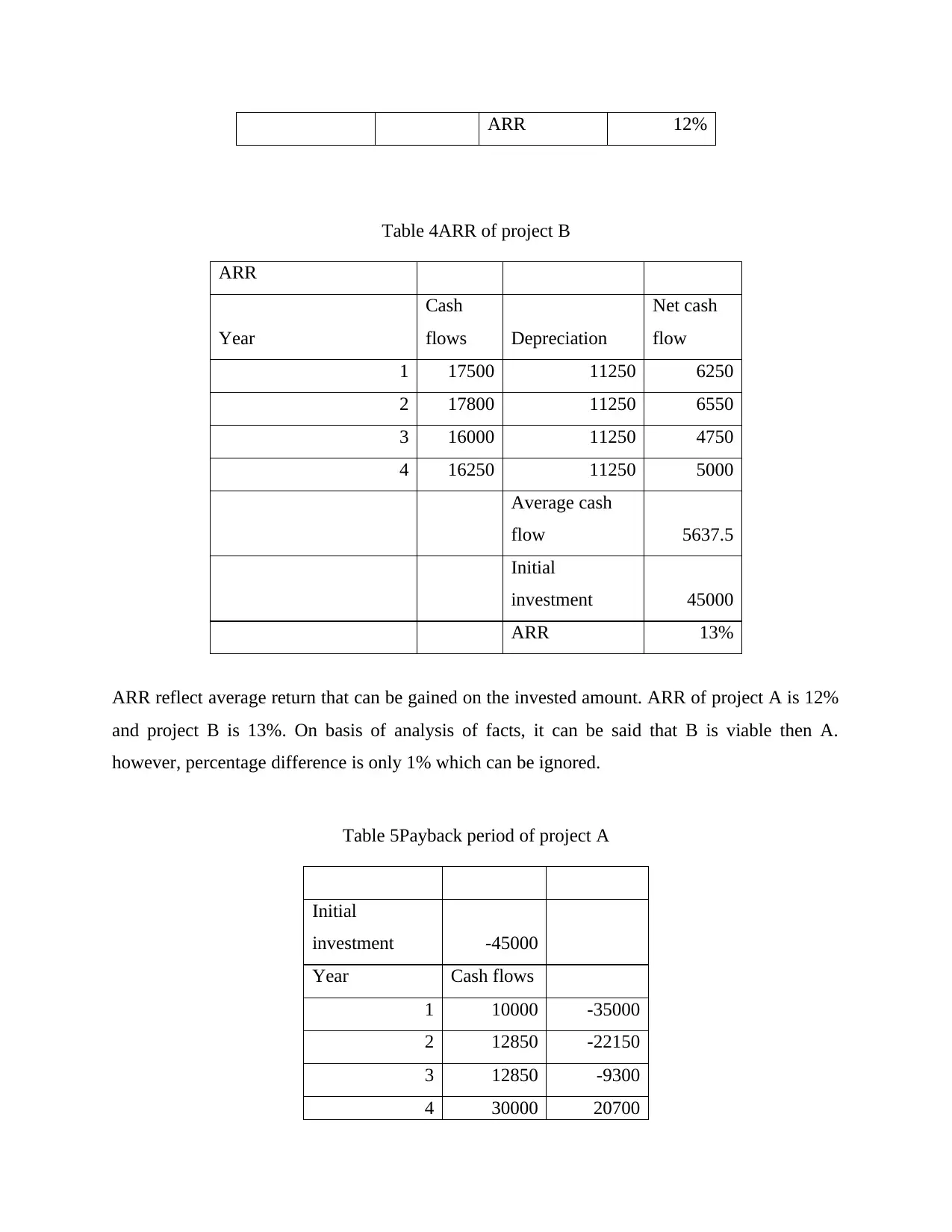
ARR 12%
Table 4ARR of project B
ARR
Year
Cash
flows Depreciation
Net cash
flow
1 17500 11250 6250
2 17800 11250 6550
3 16000 11250 4750
4 16250 11250 5000
Average cash
flow 5637.5
Initial
investment 45000
ARR 13%
ARR reflect average return that can be gained on the invested amount. ARR of project A is 12%
and project B is 13%. On basis of analysis of facts, it can be said that B is viable then A.
however, percentage difference is only 1% which can be ignored.
Table 5Payback period of project A
Initial
investment -45000
Year Cash flows
1 10000 -35000
2 12850 -22150
3 12850 -9300
4 30000 20700
Table 4ARR of project B
ARR
Year
Cash
flows Depreciation
Net cash
flow
1 17500 11250 6250
2 17800 11250 6550
3 16000 11250 4750
4 16250 11250 5000
Average cash
flow 5637.5
Initial
investment 45000
ARR 13%
ARR reflect average return that can be gained on the invested amount. ARR of project A is 12%
and project B is 13%. On basis of analysis of facts, it can be said that B is viable then A.
however, percentage difference is only 1% which can be ignored.
Table 5Payback period of project A
Initial
investment -45000
Year Cash flows
1 10000 -35000
2 12850 -22150
3 12850 -9300
4 30000 20700
⊘ This is a preview!⊘
Do you want full access?
Subscribe today to unlock all pages.

Trusted by 1+ million students worldwide
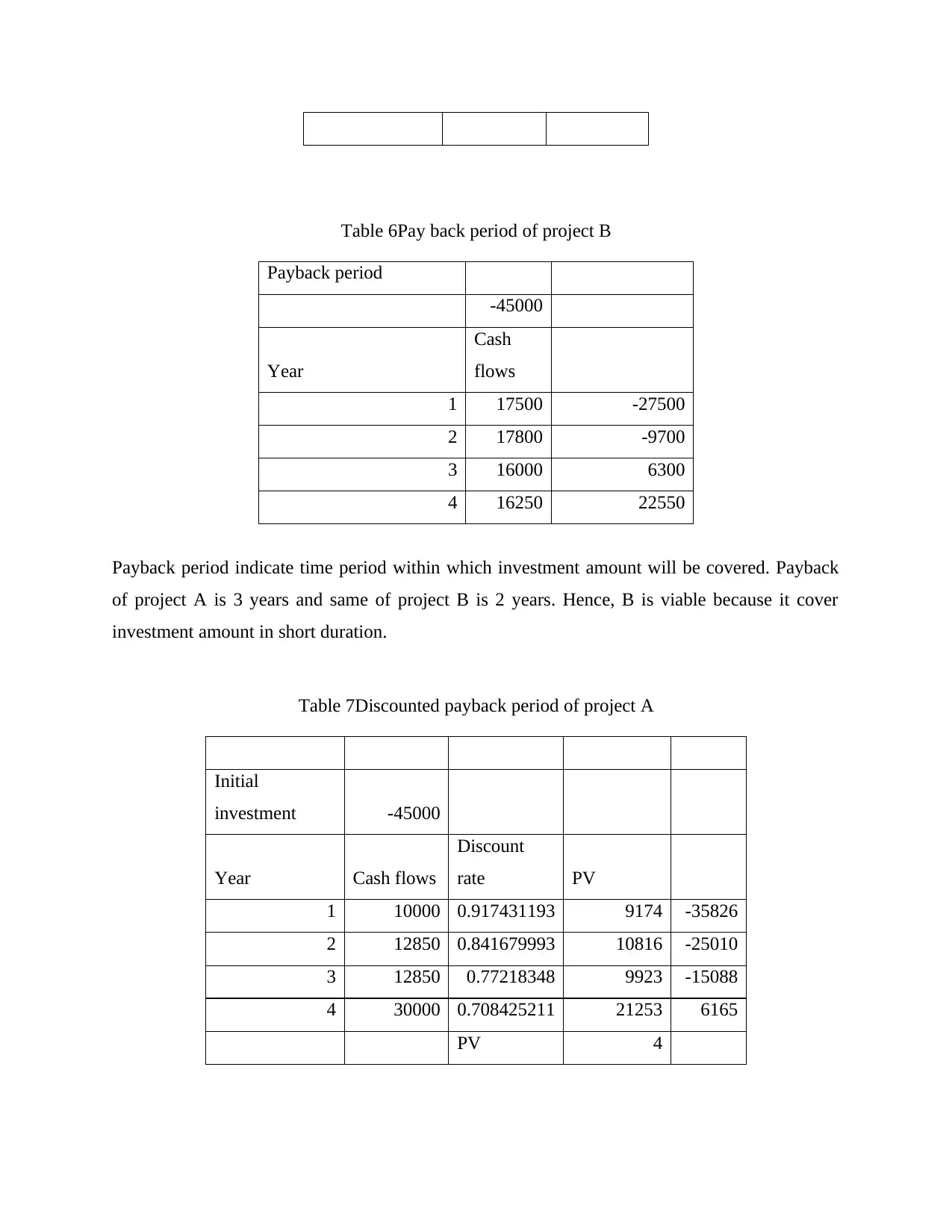
Table 6Pay back period of project B
Payback period
-45000
Year
Cash
flows
1 17500 -27500
2 17800 -9700
3 16000 6300
4 16250 22550
Payback period indicate time period within which investment amount will be covered. Payback
of project A is 3 years and same of project B is 2 years. Hence, B is viable because it cover
investment amount in short duration.
Table 7Discounted payback period of project A
Initial
investment -45000
Year Cash flows
Discount
rate PV
1 10000 0.917431193 9174 -35826
2 12850 0.841679993 10816 -25010
3 12850 0.77218348 9923 -15088
4 30000 0.708425211 21253 6165
PV 4
Payback period
-45000
Year
Cash
flows
1 17500 -27500
2 17800 -9700
3 16000 6300
4 16250 22550
Payback period indicate time period within which investment amount will be covered. Payback
of project A is 3 years and same of project B is 2 years. Hence, B is viable because it cover
investment amount in short duration.
Table 7Discounted payback period of project A
Initial
investment -45000
Year Cash flows
Discount
rate PV
1 10000 0.917431193 9174 -35826
2 12850 0.841679993 10816 -25010
3 12850 0.77218348 9923 -15088
4 30000 0.708425211 21253 6165
PV 4
Paraphrase This Document
Need a fresh take? Get an instant paraphrase of this document with our AI Paraphraser

Table 8Discounted payback period of project B
Initial investment -45000
Year
Cash
flows Discount rate PV
1 17500 0.917431193 16055 -28945
2 17800 0.841679993 14982 -13963
3 16000 0.77218348 12355 -1608
4 16250 0.708425211 11512 9904
PV 7
On front of discounted payback period method, it can be said that both projects are not viable.
Table 9NPV of project A
Initial investment 45000
Year Cash flows
Discount
rate PV
1 10000 0.917431193 9174
2 12850 0.841679993 10816
3 12850 0.77218348 9923
4 30000 0.708425211 21253
Total PV 51165
NPV 6165
Table 10NPV of project B
Initial investment 45000
Year
Cash
flows Discount rate PV
Initial investment -45000
Year
Cash
flows Discount rate PV
1 17500 0.917431193 16055 -28945
2 17800 0.841679993 14982 -13963
3 16000 0.77218348 12355 -1608
4 16250 0.708425211 11512 9904
PV 7
On front of discounted payback period method, it can be said that both projects are not viable.
Table 9NPV of project A
Initial investment 45000
Year Cash flows
Discount
rate PV
1 10000 0.917431193 9174
2 12850 0.841679993 10816
3 12850 0.77218348 9923
4 30000 0.708425211 21253
Total PV 51165
NPV 6165
Table 10NPV of project B
Initial investment 45000
Year
Cash
flows Discount rate PV
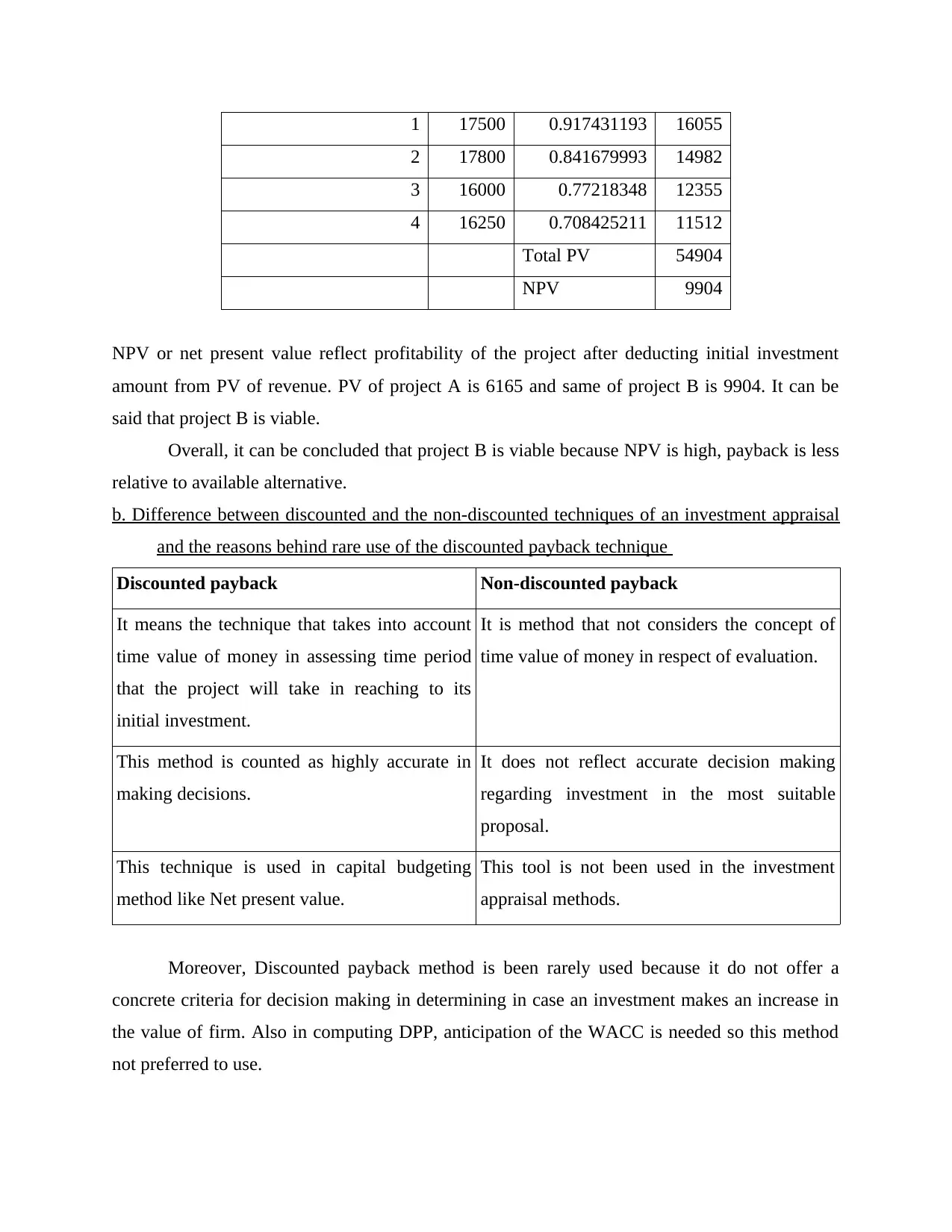
1 17500 0.917431193 16055
2 17800 0.841679993 14982
3 16000 0.77218348 12355
4 16250 0.708425211 11512
Total PV 54904
NPV 9904
NPV or net present value reflect profitability of the project after deducting initial investment
amount from PV of revenue. PV of project A is 6165 and same of project B is 9904. It can be
said that project B is viable.
Overall, it can be concluded that project B is viable because NPV is high, payback is less
relative to available alternative.
b. Difference between discounted and the non-discounted techniques of an investment appraisal
and the reasons behind rare use of the discounted payback technique
Discounted payback Non-discounted payback
It means the technique that takes into account
time value of money in assessing time period
that the project will take in reaching to its
initial investment.
It is method that not considers the concept of
time value of money in respect of evaluation.
This method is counted as highly accurate in
making decisions.
It does not reflect accurate decision making
regarding investment in the most suitable
proposal.
This technique is used in capital budgeting
method like Net present value.
This tool is not been used in the investment
appraisal methods.
Moreover, Discounted payback method is been rarely used because it do not offer a
concrete criteria for decision making in determining in case an investment makes an increase in
the value of firm. Also in computing DPP, anticipation of the WACC is needed so this method
not preferred to use.
2 17800 0.841679993 14982
3 16000 0.77218348 12355
4 16250 0.708425211 11512
Total PV 54904
NPV 9904
NPV or net present value reflect profitability of the project after deducting initial investment
amount from PV of revenue. PV of project A is 6165 and same of project B is 9904. It can be
said that project B is viable.
Overall, it can be concluded that project B is viable because NPV is high, payback is less
relative to available alternative.
b. Difference between discounted and the non-discounted techniques of an investment appraisal
and the reasons behind rare use of the discounted payback technique
Discounted payback Non-discounted payback
It means the technique that takes into account
time value of money in assessing time period
that the project will take in reaching to its
initial investment.
It is method that not considers the concept of
time value of money in respect of evaluation.
This method is counted as highly accurate in
making decisions.
It does not reflect accurate decision making
regarding investment in the most suitable
proposal.
This technique is used in capital budgeting
method like Net present value.
This tool is not been used in the investment
appraisal methods.
Moreover, Discounted payback method is been rarely used because it do not offer a
concrete criteria for decision making in determining in case an investment makes an increase in
the value of firm. Also in computing DPP, anticipation of the WACC is needed so this method
not preferred to use.
⊘ This is a preview!⊘
Do you want full access?
Subscribe today to unlock all pages.

Trusted by 1+ million students worldwide

Paraphrase This Document
Need a fresh take? Get an instant paraphrase of this document with our AI Paraphraser
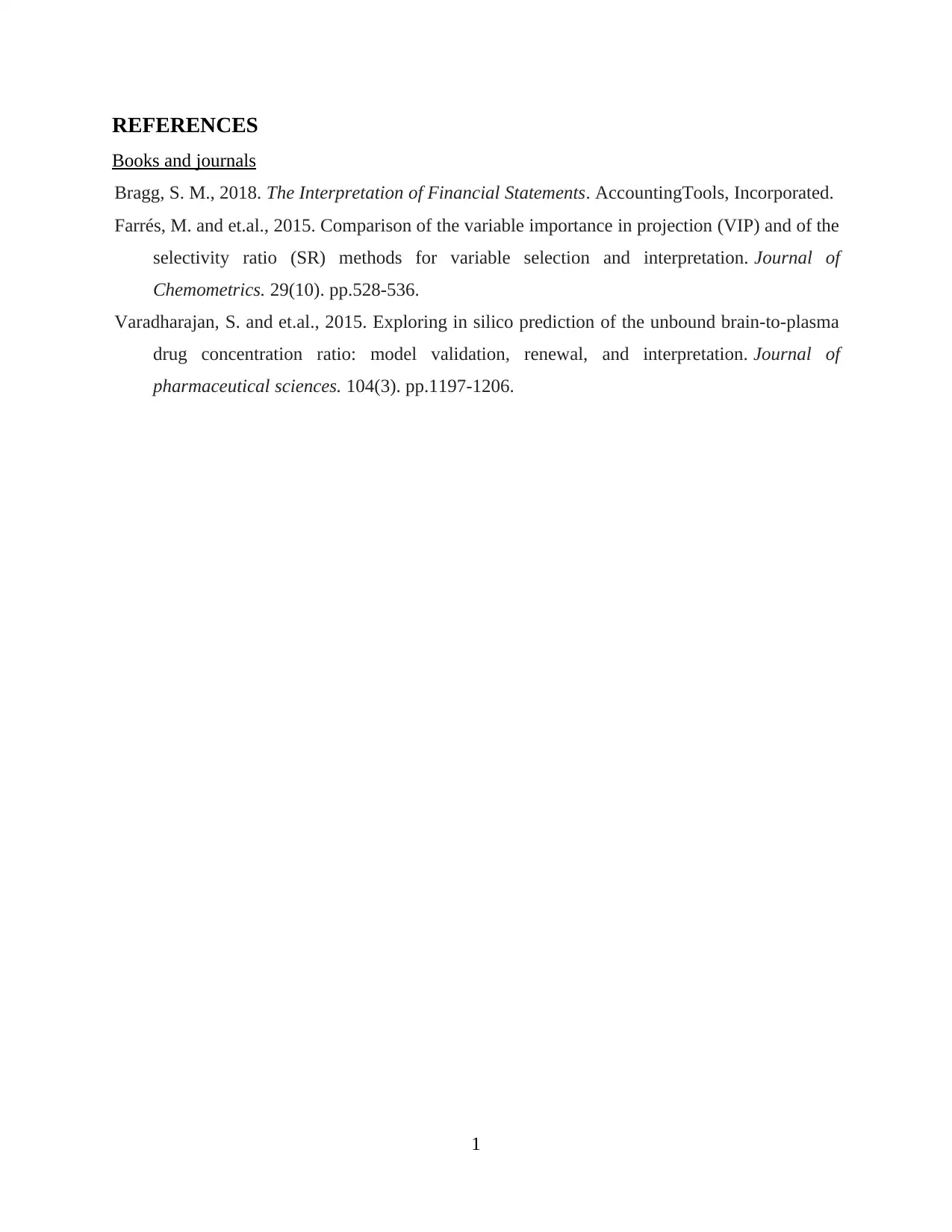
REFERENCES
Books and journals
Bragg, S. M., 2018. The Interpretation of Financial Statements. AccountingTools, Incorporated.
Farrés, M. and et.al., 2015. Comparison of the variable importance in projection (VIP) and of the
selectivity ratio (SR) methods for variable selection and interpretation. Journal of
Chemometrics. 29(10). pp.528-536.
Varadharajan, S. and et.al., 2015. Exploring in silico prediction of the unbound brain-to-plasma
drug concentration ratio: model validation, renewal, and interpretation. Journal of
pharmaceutical sciences. 104(3). pp.1197-1206.
1
Books and journals
Bragg, S. M., 2018. The Interpretation of Financial Statements. AccountingTools, Incorporated.
Farrés, M. and et.al., 2015. Comparison of the variable importance in projection (VIP) and of the
selectivity ratio (SR) methods for variable selection and interpretation. Journal of
Chemometrics. 29(10). pp.528-536.
Varadharajan, S. and et.al., 2015. Exploring in silico prediction of the unbound brain-to-plasma
drug concentration ratio: model validation, renewal, and interpretation. Journal of
pharmaceutical sciences. 104(3). pp.1197-1206.
1
1 out of 11
Related Documents
Your All-in-One AI-Powered Toolkit for Academic Success.
+13062052269
info@desklib.com
Available 24*7 on WhatsApp / Email
![[object Object]](/_next/static/media/star-bottom.7253800d.svg)
Unlock your academic potential
Copyright © 2020–2025 A2Z Services. All Rights Reserved. Developed and managed by ZUCOL.



